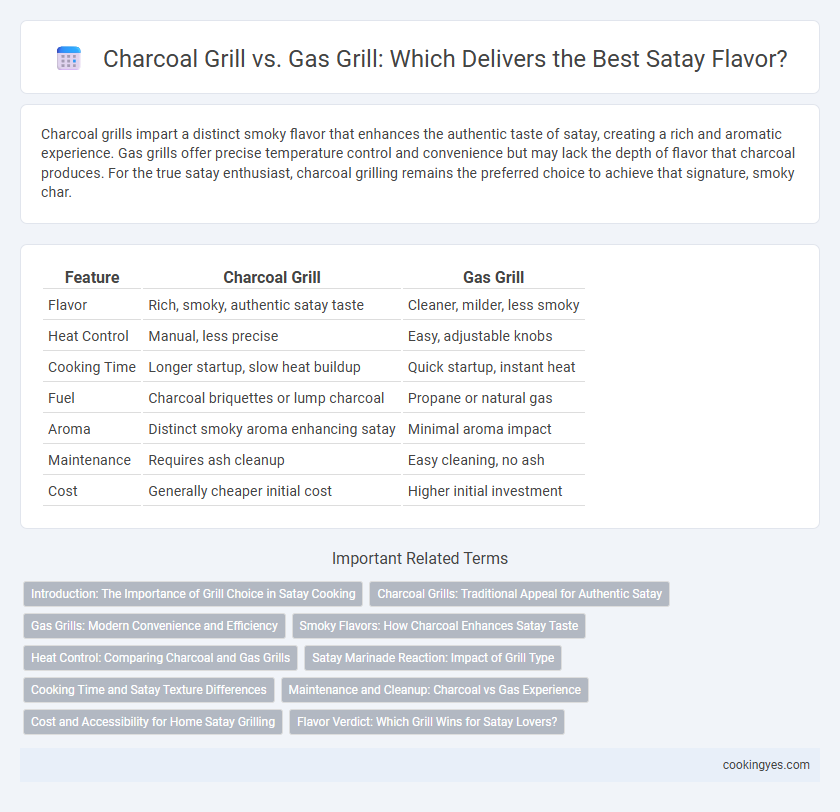Charcoal grills impart a distinct smoky flavor that enhances the authentic taste of satay, creating a rich and aromatic experience. Gas grills offer precise temperature control and convenience but may lack the depth of flavor that charcoal produces. For the true satay enthusiast, charcoal grilling remains the preferred choice to achieve that signature, smoky char.
Table of Comparison
| Feature | Charcoal Grill | Gas Grill |
|---|---|---|
| Flavor | Rich, smoky, authentic satay taste | Cleaner, milder, less smoky |
| Heat Control | Manual, less precise | Easy, adjustable knobs |
| Cooking Time | Longer startup, slow heat buildup | Quick startup, instant heat |
| Fuel | Charcoal briquettes or lump charcoal | Propane or natural gas |
| Aroma | Distinct smoky aroma enhancing satay | Minimal aroma impact |
| Maintenance | Requires ash cleanup | Easy cleaning, no ash |
| Cost | Generally cheaper initial cost | Higher initial investment |
Introduction: The Importance of Grill Choice in Satay Cooking
Charcoal grills impart a smoky, rich aroma that enhances satay's traditional flavor by infusing meat with subtle wood-smoke nuances. Gas grills offer precise temperature control and cleaner heat, ensuring even cooking but often lack the deep, complex taste of charcoal. Selecting the right grill significantly influences satay's authentic texture and aromatic profile, making grill choice crucial in achieving the perfect satay experience.
Charcoal Grills: Traditional Appeal for Authentic Satay
Charcoal grills enhance satay's flavor by imparting a smoky, rich aroma that gas grills often cannot replicate, preserving the traditional appeal sought by enthusiasts. The slow, uneven heat from charcoal allows skewers to develop a deeper caramelized crust, essential for authentic satay taste. This method aligns with historical cooking practices in Southeast Asian cuisine, maintaining the beloved smoky essence integral to satay's signature flavor profile.
Gas Grills: Modern Convenience and Efficiency
Gas grills offer modern convenience and precise temperature control that enhances satay preparation, allowing for consistent cooking without the fluctuations common in charcoal grilling. Their efficient heat distribution reduces cooking time and maintains juiciness while enabling easy adjustments to avoid overcooking the delicate satay meat. Designed for cleaner operation, gas grills minimize smoke exposure, preserving the authentic satay flavor with less environmental impact and hassle.
Smoky Flavors: How Charcoal Enhances Satay Taste
Charcoal grills produce a distinct smoky aroma that infuses satay with deep, rich flavors derived from the natural burning wood and charcoal. The slow, intense heat of charcoal allows the meat to develop a caramelized crust while absorbing the signature smokiness essential for authentic satay. Gas grills lack the same aromatic smoke, often resulting in a cleaner but less flavorful satay experience.
Heat Control: Comparing Charcoal and Gas Grills
Charcoal grills provide intense, uneven heat that enhances satay with a smoky, authentic flavor, but require skillful management to maintain consistent temperatures. Gas grills offer precise heat control through adjustable knobs, allowing for steady, uniform cooking ideal for delicate satay skewers. The ability to regulate temperature quickly makes gas grills convenient, while charcoal's natural aroma remains unmatched for traditional satay flavor.
Satay Marinade Reaction: Impact of Grill Type
Charcoal grills enhance satay flavor by producing higher heat and smoky compounds that intensify the marinade's caramelization and Maillard reaction, resulting in a richer, more complex taste. Gas grills offer consistent temperature control but lack the smoky aroma that interacts with the marinade's sugars and proteins to create depth in satay's flavor profile. The chemical reaction between satay marinade and charcoal smoke elevates the savory and slightly sweet notes, making charcoal grilling the preferred method for authentic satay flavor.
Cooking Time and Satay Texture Differences
Charcoal grills impart a smoky aroma and crispy texture to satay due to higher, uneven heat and longer cooking times, enhancing flavor complexity. Gas grills offer quicker, more consistent heat, resulting in faster cooking but a less intense smoky taste and a softer, more uniform texture. Choosing between charcoal and gas grills affects satay's texture and flavor profile, balancing smoky depth versus cooking efficiency.
Maintenance and Cleanup: Charcoal vs Gas Experience
Charcoal grills require more frequent ash removal and thorough cleaning after each use due to residue buildup, impacting maintenance time for satay preparation. Gas grills offer a cleaner and quicker cleanup process with fewer residues, making them more convenient for regular satay cooking. Proper maintenance of charcoal grills ensures better flavor but demands more effort, whereas gas grills prioritize ease with moderate flavor compromise.
Cost and Accessibility for Home Satay Grilling
Charcoal grills provide authentic smoky flavors essential to traditional satay but often require more time and effort to start, with charcoal costs varying by brand and availability. Gas grills offer consistent heat and easier ignition, with upfront costs generally higher but operational expenses lower due to reusable fuel; propane refills are widely accessible in urban areas. For home satay grilling, charcoal remains preferred for flavor authenticity, while gas grills appeal to convenience and steady temperature control.
Flavor Verdict: Which Grill Wins for Satay Lovers?
Charcoal grills impart a smoky, rich flavor to satay that gas grills struggle to replicate, making them the preferred choice for authentic taste aficionados. The intense heat and natural aroma from burning charcoal enhance the caramelization and depth of the satay's marinade. While gas grills offer convenience and temperature control, charcoal remains the flavor champion for true satay lovers seeking that signature smoky essence.
Charcoal Grill vs Gas Grill for Satay Flavor Infographic

 cookingyes.com
cookingyes.com